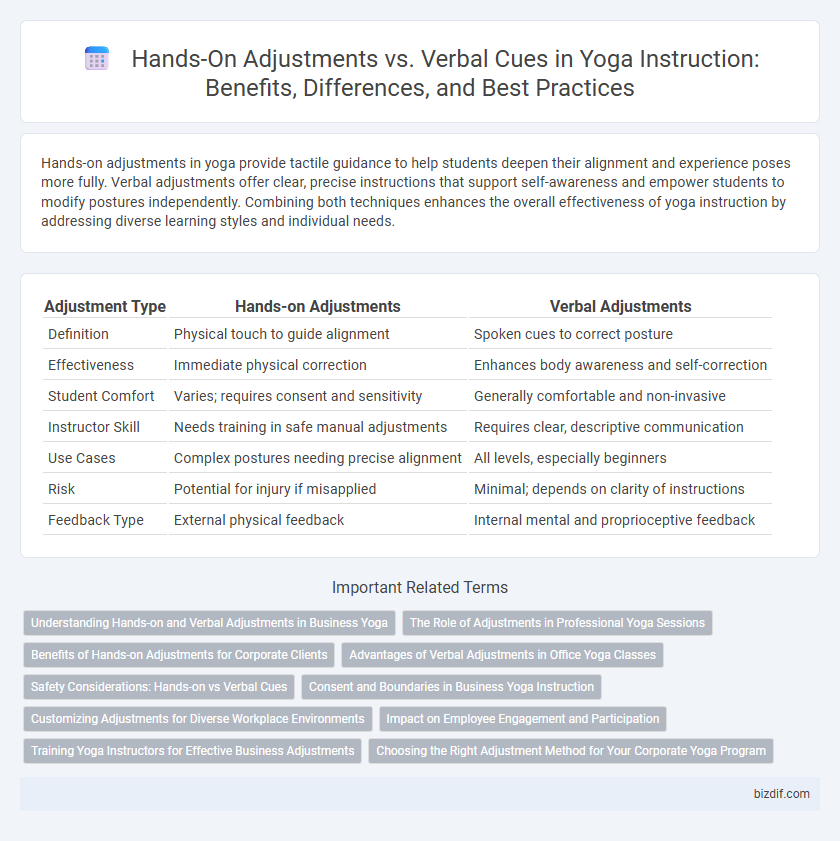Hands-on adjustments in yoga provide tactile guidance to help students deepen their alignment and experience poses more fully. Verbal adjustments offer clear, precise instructions that support self-awareness and empower students to modify postures independently. Combining both techniques enhances the overall effectiveness of yoga instruction by addressing diverse learning styles and individual needs.
Table of Comparison
| Adjustment Type | Hands-on Adjustments | Verbal Adjustments |
|---|---|---|
| Definition | Physical touch to guide alignment | Spoken cues to correct posture |
| Effectiveness | Immediate physical correction | Enhances body awareness and self-correction |
| Student Comfort | Varies; requires consent and sensitivity | Generally comfortable and non-invasive |
| Instructor Skill | Needs training in safe manual adjustments | Requires clear, descriptive communication |
| Use Cases | Complex postures needing precise alignment | All levels, especially beginners |
| Risk | Potential for injury if misapplied | Minimal; depends on clarity of instructions |
| Feedback Type | External physical feedback | Internal mental and proprioceptive feedback |
Understanding Hands-on and Verbal Adjustments in Business Yoga
Hands-on adjustments in business yoga provide precise physical guidance to enhance alignment and deepen poses, catering to individual needs and improving practitioner safety. Verbal adjustments offer clear, descriptive cues that facilitate mental focus and self-awareness, helping clients internalize proper techniques and foster autonomy. Combining both methods optimizes client experience and retention by addressing diverse learning styles within corporate wellness programs.
The Role of Adjustments in Professional Yoga Sessions
Hands-on adjustments in professional yoga sessions provide precise alignment corrections, enhancing body awareness and preventing injuries. Verbal adjustments serve to guide practitioners through cues that promote self-correction and deepen their practice without physical contact. Effective integration of both methods fosters a supportive learning environment that accommodates diverse student needs and skill levels.
Benefits of Hands-on Adjustments for Corporate Clients
Hands-on adjustments in yoga provide corporate clients immediate physical alignment corrections, enhancing posture and reducing work-related musculoskeletal issues. This tactile guidance fosters deeper body awareness and helps overcome mental barriers, promoting relaxation and stress relief during sessions. By offering personalized support, hands-on adjustments improve overall engagement and effectiveness of yoga practice within demanding corporate environments.
Advantages of Verbal Adjustments in Office Yoga Classes
Verbal adjustments in office yoga classes promote autonomy and respect personal boundaries, making participants feel more comfortable in a professional setting. Clear verbal cues enhance body awareness and alignment without physical contact, reducing the risk of injury and maintaining hygiene standards. This approach fosters effective communication and encourages self-correction, crucial for adapting yoga practices to individual needs in limited office spaces.
Safety Considerations: Hands-on vs Verbal Cues
Hands-on adjustments in yoga require strict awareness of personal boundaries and practitioner consent to prevent injury or discomfort, prioritizing gentle, precise contact that respects individual anatomy. Verbal adjustments enhance safety by providing clear, non-invasive guidance that allows students to maintain autonomy over their movements and adjust poses at their own pace. Effective instruction balances both methods, ensuring corrections align with each student's comfort level and physical capability to foster a safe practice environment.
Consent and Boundaries in Business Yoga Instruction
Prioritizing consent in business yoga instruction enhances student comfort and trust during hands-on adjustments, ensuring boundaries are respected and personal space is maintained. Verbal adjustments offer an alternative by providing clear, respectful guidance without physical contact, accommodating diverse preferences and cultural sensitivities. Establishing transparent communication policies fosters a safe environment that honors individual autonomy and reinforces professional ethics in yoga teaching.
Customizing Adjustments for Diverse Workplace Environments
Customizing hands-on and verbal adjustments in yoga instruction requires understanding individual comfort levels and workplace culture to ensure respect and safety. Hands-on adjustments offer precise physical alignment corrections, while verbal cues provide clear guidance adaptable to remote or hybrid work settings. Combining both methods supports diverse employee needs, enhancing engagement and promoting well-being across various workplace environments.
Impact on Employee Engagement and Participation
Hands-on adjustments in yoga instruction foster deeper employee engagement by creating personalized physical alignment cues, which enhance body awareness and boost confidence during practice. Verbal adjustments supplement this by providing clear, immediate feedback that supports understanding and self-correction, promoting active participation. Combining both methods maximizes employee involvement, encouraging sustained commitment and improved performance in workplace wellness programs.
Training Yoga Instructors for Effective Business Adjustments
Hands-on adjustments in yoga instruction provide tactile guidance for alignment and engagement, enhancing student body awareness more effectively than verbal cues alone. Training yoga instructors to skillfully combine hands-on and verbal adjustments fosters a supportive, personalized experience that improves student retention and satisfaction. Developing proficiency in both adjustment methods enhances instructor credibility and drives business growth through positive word-of-mouth and client loyalty.
Choosing the Right Adjustment Method for Your Corporate Yoga Program
Selecting the appropriate adjustment method in a corporate yoga program enhances participant comfort and engagement, with hands-on adjustments offering personalized support and verbal cues promoting independence and mindfulness. Evaluating company culture and individual preferences helps determine the balance between tactile guidance and clear, concise verbal instructions. Integrating both methods thoughtfully maximizes accessibility and fosters a positive, inclusive environment for all employees.
Hands-on Adjustments vs Verbal Adjustments Infographic

 bizdif.com
bizdif.com